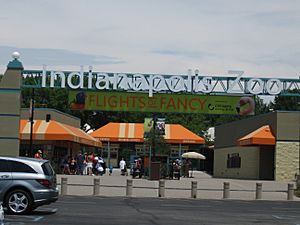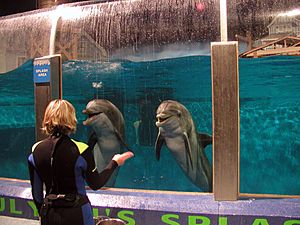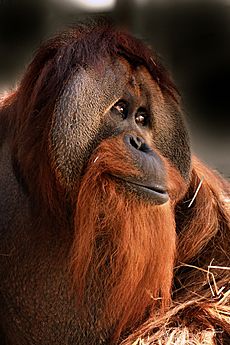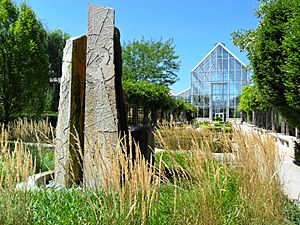Indianapolis Zoo facts for kids

Zoo entrance (2012)
|
|
| Date opened | April 18, 1964 |
|---|---|
| Location | Indianapolis, Indiana, U.S. |
| Land area | 64 acres (26 ha) |
| Coordinates | 39°46′1″N 86°10′37″W / 39.76694°N 86.17694°W |
| No. of animals | 3,800 |
| No. of species | 320 |
| Annual visitors | 1.1 million (2019) |
| Memberships | AZA, AAM |
The Indianapolis Zoo is a fun place to visit in Indianapolis, Indiana, USA. It's home to over 3,800 animals from more than 320 different kinds of species! This amazing zoo is special because it's recognized as a zoo, an aquarium (for water animals), and a botanical garden (for plants).
The zoo is a private, non-profit organization. This means it doesn't get money from taxes. Instead, it relies on money from tickets, memberships, donations, and special events to take care of all its animals and plants.
Contents
History of the Indianapolis Zoo
The idea for the Indianapolis Zoo started way back in 1944. A newspaper writer named Lowell B. Nussbaum wrote in his column about wanting a zoo in the city. His ideas inspired many people in Indianapolis.
In October 1944, a group called the "Indianapolis Zoological Society, INC" was formed. They planned for the zoo to be supported by ticket sales, memberships, and donations. The zoo first opened its doors to the public in 1964.
First Home: George Washington Park
The Indianapolis Zoo officially opened on April 18, 1964. Its first location was in George Washington Park. This was 20 years after the idea for the zoo first came about!
In its first year, over 270,000 people visited the new zoo. Some of the first animals included an Asian elephant, penguins, kangaroos, and bison. In 1965, the zoo became one of the first in the country to have a full-time education team. This team helped teach visitors about the animals.
By the zoo's 20th birthday, its animal collection had grown a lot. It became clear that the zoo needed a bigger place to keep expanding.
In 1982, experts from zoos, aquariums, and wildlife groups met to plan the new zoo. They decided that a zoo should not just be a place to see animals. It should also help with conservation (protecting animals) and education. That same year, White River State Park was chosen as the new home for the zoo. Construction began in September 1985, and the old zoo closed in 1987.
New Home: White River State Park
The current Indianapolis Zoo opened in White River State Park in 1988. It covers a large area of 64 acres (26 ha).
After building the Waters building and the Dolphin Pavilion, the zoo was also recognized as an aquarium. Then, in 1996, the Indianapolis Zoo became the first place to be recognized as a zoo, an aquarium, AND a botanical garden! The White River Gardens were once a separate area, but now they are part of the zoo.
Today, over a million people visit the zoo each year. The zoo also plays a big part in worldwide conservation and research. For example, it was the first zoo in the world to successfully use artificial insemination to help an African elephant have a baby.
Biomes: Animal Habitats
The Indianapolis Zoo is set up around the idea of biomes. Biomes are like big natural neighborhoods on Earth. They have similar climate (weather), plants, and animals. At the Indianapolis Zoo, animals are grouped together in exhibits that look like their natural biomes.
You can visit five main biomes at the Indianapolis Zoo:
Oceans Biome
This biome is all about amazing sea creatures!
Pinniped Shore
First Tanks
- Cownose ray
- Smooth dogfish shark
- Tang fish
- Unicorn fish
- Butterfly fish
- Coral
- Sea anemones
- Green moray eel
- Angelfish
- Red lionfish
Shark Touch Pool
- Smooth dogfish shark
- Cownose Ray
- Southern Stingray
Tube Tanks
Small Tanks
- Starfish
- Cardinal fish
Penguin Hall
Sharing One World: Long-Tailed Macaques
Walrus Complex
Dolphin Pavilion
Forests Biome
Step into the Forests biome to see animals that live among trees and lush plants.
Commons
China Display
Tiger Forest
Magnificent Macaws
- Great green macaw
- Green-winged macaw
- Scarlet macaw
- Hyacinth macaw
- Blue and gold macaw
- Military macaw
- Blue-throated macaw
Other Exhibits
MISTery Park
Deserts Biome
Explore the dry and sandy world of the Deserts biome.
Dome Exhibits
- Rhinoceros iguana
- Mali spiny-tailed lizard
- Blue-tongued skink
- Central bearded dragon
- Grand cayman blue iguana
- Desert tortoise
- Radiated tortoise
- Egyptian tortoise
- Northern bobwhite quail
- Meerkat
- Great plated lizard
- Chuckwalla
- Colorado River toad
- Jamaican iguana
Size, Speed, and Venom: Extreme Snakes
- Reticulated python
- Copperhead
- Timber rattlesnake
- Cottonmouth
- Black mamba
- Eastern green mamba
- Burmese python
- Gaboon viper
- Cape cobra
- Red spitting cobra
Other Reptile Exhibits
- Gila monster
- Massasauga rattlesnake
- Santa catalina rattlesnake
- Spotted python
- Green tree python
- Hognose snake
- Madagascar tree boa
- Eyelash viper
- Green iguana
Rest of Dome
International Orangutan Center
Flights of Fancy
This area is full of colorful birds!
Flamingo Pool
Budgie Aviary
Lorikeet Aviary
- Red lory
- Rainbow lorikeet
- Green-naped lorkeet
- Cabot's tragopan
- Crested wood partridge
- Green woodhoopoe
- Superb starling
- Taveta golden weaver
- White-cheeked turaco
- Vulturine guineafowl
- Blue-bellied Roller
Other Animals
Plains Biome
Journey to the Plains biome to see animals from wide-open grasslands.
- Grant's zebra
- Greater kudu
- White-bearded wildebeest
- Thomson's gazelle
- Ostrich
- Marabou stork
- Ruppell's griffon vulture
- Addra gazelle
- Reticulated giraffe
- Southern white rhino
- African lion
- Guinea baboon
- Cheetah
- African crowned crane
- Crested coua
- Helmeted guineafowl
- Eastern yellow-billed hornbill
- African bush elephant
- Warthog
- Cape porcupine
White River Gardens
St. Vincent Dolphin Pavilion
One of the most exciting parts of the Indianapolis Zoo is its large dolphin pavilion. Here, you can see dolphins up close and even interact with them!
The pavilion has a special underwater viewing dome. It's 30-foot (9.1 m) wide and 12-foot (3.7 m) high, right in the middle of the dolphin pool. This means you can watch the dolphins swim and play from underneath the water! This was the first time a U.S. zoo had such a feature when it opened in 2005.
Above the water, the St. Vincent Dolphin Theater has a huge pool with over a million gallons of water. Daily dolphin shows happen here. There are 11 bottlenose dolphins living at the zoo, including Calypso, China, Jett, Kimo, and Indy.
The zoo also offers a unique program where visitors can get into the water with the dolphins. It's the only program like it in the Midwest!
International Orangutan Center
In 2012, the Indianapolis Zoo started building a new, amazing home for orangutans. This project cost $21.5 million and is called the Simon Skjodt International Orangutan Center. It's not just an exhibit for visitors; it's also a place for research to help protect orangutans in the wild.
The center is home to nine orangutans. It has a tall viewing area, 90 feet high, where you can watch them. There's even an aerial cable ride that gives you a special view of the animals from above. The orangutans can travel all over the zoo using a series of "cable highways." This cool exhibit opened in 2014.
MISTery Park
MISTery Park is a beautiful path with flowers, tall grasses, and trees. It has misters that create a cool fog, making it a refreshing place to walk. This park is also where you can find the two-toed sloth exhibit. It opened in 2019.
Other Fun Rides and Attractions
The Indianapolis Zoo has more than just animals! You can also enjoy these activities:
- Flamingo Feed Experience
- Feed a Budgie or Lorikeet
- Feed a Giraffe
- Race-a-Cheetah
- Kombo Family Coaster
- White River Junction Train Ride
- Endangered Species Carousel
- Skyline (a ride that takes you above the zoo)
- Playground
- Tots Treehouse and Play Area
Conservation and Research Efforts
The Indianapolis Zoo works hard to protect animals and their habitats. They do this in many ways.
The zoo gives out the Indianapolis Prize. This is a big award for people who have done amazing things to save animal species. The winner gets a US$250,000 cash prize and a special medal. It's given out every two years.
The Indianapolis Zoo also takes part in Species Survival Plans (SSPs). These are programs run by the Association of Zoos and Aquariums (AZA) to help manage and protect animal populations in zoos. The zoo also does its own research projects to learn more about animals and how to help them.
They support important groups like the International Elephant Foundation, the International Iguana Foundation, and the International Rhino Foundation. The zoo even helps a project in Tanzania, Africa, to protect paths that elephants use to migrate.
Notable Animals: Rocky the Orangutan
Rocky's Unique Abilities
Rocky is a male orangutan born on September 25, 2004. He came to the Indianapolis Zoo before the International Orangutan Center opened in 2014. Rocky is famous for his special way of "talking" and making unique sounds.
In 2017, a video of Rocky became very popular online. In the video, Rocky was interacting with a zoo visitor who had a large bandage on her arm from a burn. Rocky seemed very interested in the bandage. He gestured, as if asking her to remove it. When she did, Rocky looked closely at her burn, showing how curious and smart he is!
Images for kids











